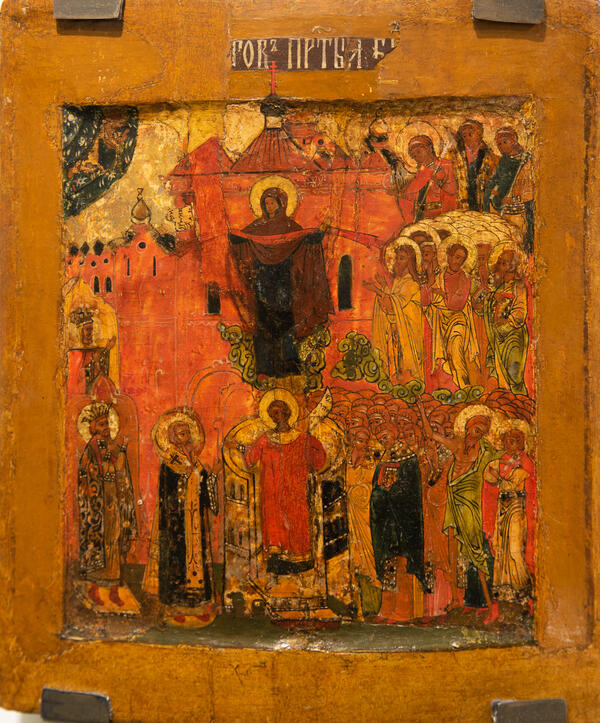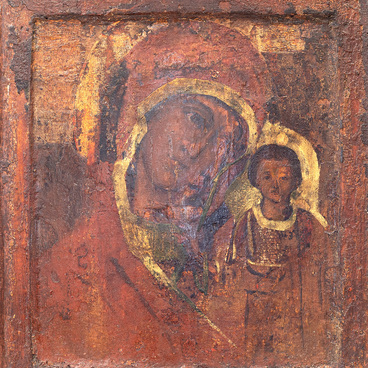The icon is part of a collection from Saint Nicholas Church in the village of Kovda, an old Pomor settlement, the famous trading port of the White Sea region, that was first mentioned in the 14th century. The temple complex of Saint Nicholas Church and the bell tower has been preserved in Kovda — it is a monument of northern wooden architecture. The iconostasis of the church in Kovda was created in the early 17th century in a single style and, probably, by craftsmen from the Solovetsky Monastery. Over time, local residents donated personal icons brought from different regions to the church.
After the temple was closed in 1960, some of the icons were distributed among the museums of the Northwestern region. The rest remained for almost 30 years in a cold, damp room of a closed church and fell into disrepair. Finally, after restoration in 1992–1994, the works were transferred to the newly created Murmansk Regional Art Museum. One of them is the icon “The Intercession of the Theotokos” in a brief iconographic version. The iconography of the Intercession has two independent directions: Novgorod and Suzdal (Central Russian). The icon from the museum’s collection belongs to the Suzdal verson and has some specific features. For example, the Mother of God holds the veil in her hands, and all the action takes place not inside the temple, but against a background of numerous church buildings. In this case, these are buildings with a gable roof and a round domed church. Such images are believed to imitate the outlines of the Blachernae Church near the emperor’s palace in Constantinople, where the event that was depicted in detail by the icon painter had happened.
The plot is based on the story from the life of Andrew the Fool about the miraculous appearance of the Mother of God during the service in the Blachernae Church in Constantinople, where her robe was kept. The event took place in 910 during the siege of the city by enemies, when the people, led by the patriarch and the emperor, gathered to pray for intercession. As a sign of patronage and protection, the Mother of God spread her veil over the worshipers.
The icon itself is small, made in warm golden-brown and red colors with dark colors used to depict the clothes of the key characters.
After the temple was closed in 1960, some of the icons were distributed among the museums of the Northwestern region. The rest remained for almost 30 years in a cold, damp room of a closed church and fell into disrepair. Finally, after restoration in 1992–1994, the works were transferred to the newly created Murmansk Regional Art Museum. One of them is the icon “The Intercession of the Theotokos” in a brief iconographic version. The iconography of the Intercession has two independent directions: Novgorod and Suzdal (Central Russian). The icon from the museum’s collection belongs to the Suzdal verson and has some specific features. For example, the Mother of God holds the veil in her hands, and all the action takes place not inside the temple, but against a background of numerous church buildings. In this case, these are buildings with a gable roof and a round domed church. Such images are believed to imitate the outlines of the Blachernae Church near the emperor’s palace in Constantinople, where the event that was depicted in detail by the icon painter had happened.
The plot is based on the story from the life of Andrew the Fool about the miraculous appearance of the Mother of God during the service in the Blachernae Church in Constantinople, where her robe was kept. The event took place in 910 during the siege of the city by enemies, when the people, led by the patriarch and the emperor, gathered to pray for intercession. As a sign of patronage and protection, the Mother of God spread her veil over the worshipers.
The icon itself is small, made in warm golden-brown and red colors with dark colors used to depict the clothes of the key characters.




